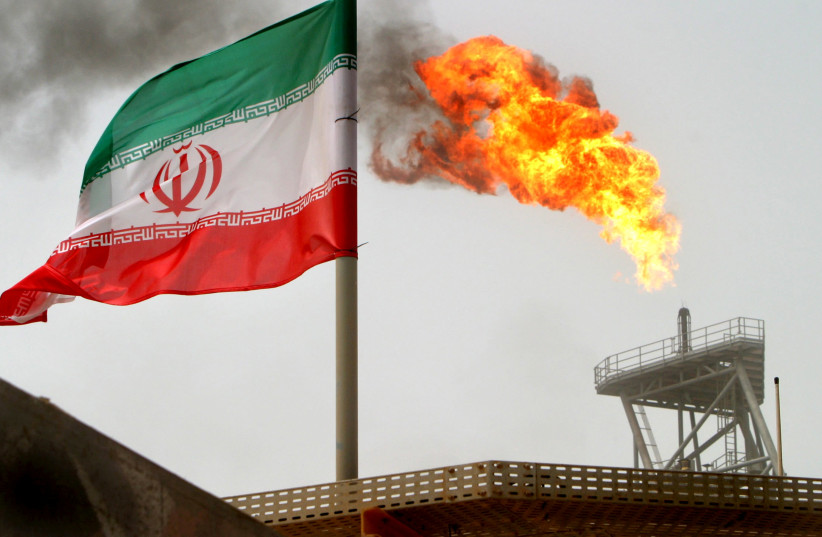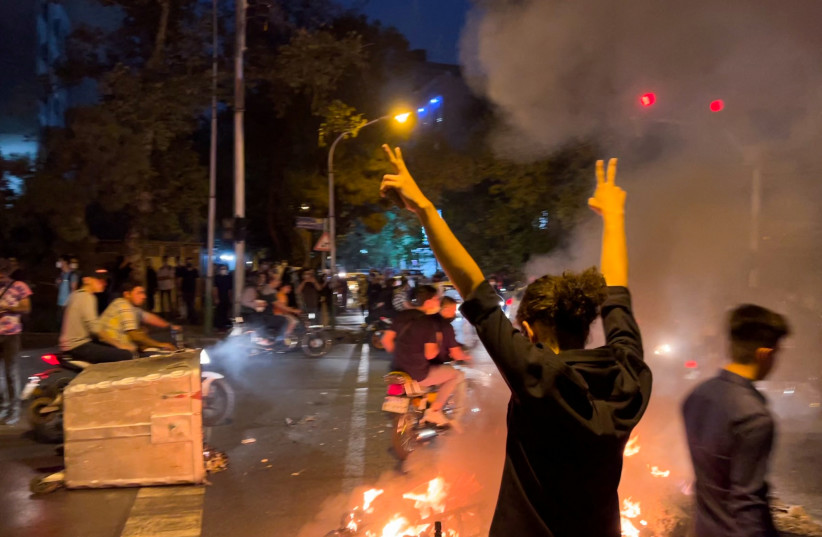Oil worker strikes were pivotal in the Islamic Revolution of 1979 which led to the fall of the Shah.

Contract workers at petrochemical plants and oil refineries across Iran went on strike on Monday and Tuesday, as protests following the killing of Mahsa Amini continued across the country for a fourth week.
Workers at the South Pars Phase 14 Conventional Gas Field stated in a video shared on social media that they were giving Iranian forces attacking protesters three days to lay down their weapons, warning that otherwise “we will destroy everything we have built.” Another video reportedly from the South Pars platform showed a worker announcing his cooperation with striking oil workers and repeating the warning that workers would “destroy everything” they built if the suppression of protesters did not cease.
«منم بختیاری منم مرد جنگ، بمیرم به نام و نمانم به ننگ»
هشدار کارگران سکوهای پارس جنوبی به نیروهای سرکوبگر
کارگران پارس جنوبی امروز طی پیامی ویدئویی خطاب به نظامیان مزدور هشدار داده بودند: اگر اسلحه را زمین نگذارید، هر چه ساختیم، تخریب میکنیم!#اعتصابات_سراسری #اعتراضات_سراسری pic.twitter.com/nWZepSdgVU— Iranworkers (@iranworkers) October 11, 2022
The Organizing Council for Protests of Oil Contract Workers had warned late last month that petrochemical workers would strike if the suppression of protesters continued.
ادامهی اعتصابات و اعتراضات کارگران پالایشگاه آبادان، امروز ۱۹ مهر ۱۴۰۱#مهسا_امینی pic.twitter.com/WNb184ky4N
— +۱۵۰۰تصویر (@1500tasvir) October 11, 2022
Starting on Monday, workers at the Hengam and Bushehr petrochemical facilities launched strikes in support of the protests taking place across the country. Workers at the Kangan petrochemical company and the Abadan Refinery joined the strikes later in the day.

The organizing council addressed oil and petrochemical workers across the country on Monday, stressing that “now is the time to protest widely and prepare ourselves for nationwide and back-breaking strikes.”
The council demanded that the government release all arrested protesters and stop attacking protesters. At least 11 striking oil workers have been since Monday, according to the council.
Footage reportedly from a petrochemical facility in Asaluyeh showed workers chanting “death to the dictator.” Additional footage showed workers gathering outside additional facilities, including in Abadan.
Oil worker strikes were pivotal in the Islamic Revolution of 1979 which led to the fall of the Shah. If the strike by oil workers continues for an extended period, it could cause significant damage to the stability of the current regime, although that would depend on a number of different issues, including who joins the strike, how the workers organize and other issues.
Governor of Bushehr, Ahmad Mohammadizadeh, called for the demands of striking workers to be given priority on Tuesday, according to Iranian media.
“All labor groups, including the government sector and employers, must protect the dignity of workers,” said the governor. “The trade union demands of the workers of South Pars region should be followed seriously and in a special way.”
Strikes have been reported in additional sectors as well amid the protests, including in markets in Tehran and in universities across the country.
The Haft Tappeh Sugarcane Agro-industrial Complex Labor Syndicate trade union has called on additional sectors and businesses to join the nationwide strike. “Freedom from oppression and exploitation, from discrimination and inequalities is possible with unity and solidarity,” said the union.
Protests continue across Iran
Extensive protests across Iran continued on Tuesday, with Iranian forces intensifying their crackdown on the demonstrators in the Kurdish city of Sanandaj and other cities.
تیراندازی مستقیم نیروهای سرکوبگر به سوی منازل شهروندان در شهرک نایسر سنندج
شامگاه دوشنبه ۱۸ مهر ۱۴۰۱#مهسا_امینی #kurdistan#MahsaAmini pic.twitter.com/nbf3riCfsw
— Hengaw Human Rights Organization (@HengawO) October 10, 2022
Heavy machine gun fire has reportedly been used to target residential buildings in Sanandaj, according to the Hengaw Human Rights Organization. Videos from Sanandaj have shown security forces shooting at homes.
درگیری شدید مردم معترض با نیروهای سرکوبگر در محله بهارستان سنندج
شامگاه دوشنبه ۱۸ مهر ۱۴۰۱ #مهسا_امینی #سنندج#MahsaAmini pic.twitter.com/cShfyjLIhD
— Hengaw Human Rights Organization (@HengawO) October 10, 2022
On Tuesday, Hengaw reported that 32 civilians have been killed in Kurdish communities since the protests began. More casualties have been reported in other cities, although the exact number remains unclear.
Activists across Iran called for largescale protests in support of Sanandaj for Wednesday and Thursday, including protests in Tehran.
On Monday night, protesters threw Molotov cocktails at the office of the Friday Prayer Imam in Fuladshahr near Isfahan, according to footage shared on social media.
ویدیو با این توضیح فرستاده شده است: بهیاد تمام دختران ایرانم در روز جهانی دختر، دفتر امامجمعهی فولادشهر را با کوکتل مولوتف آتش زدیم.#مهسا_امینی pic.twitter.com/eVstZ689w1
— +۱۵۰۰تصویر (@1500tasvir) October 11, 2022
Additionally on Monday, at the Tehran University of Art, protesting students formed the shape of the word “blood” and chanted “Women, freedom, life,” a slogan which has become popular among protesters in recent weeks.
دانشجویان دانشگاه هنر تهران به شکل کلمهی «خون» ایستاده و شعار زن زندگی آزادی میدهند.
۱۸ مهر ۱۴۰۱#مهسا_امینی pic.twitter.com/VFVKnmx2z0— +۱۵۰۰تصویر (@1500tasvir) October 11, 2022
A number of videos published on social media in recent days have shown security forces fleeing as crowds of protesters chase them.
As reported by The Jerusalem Post
